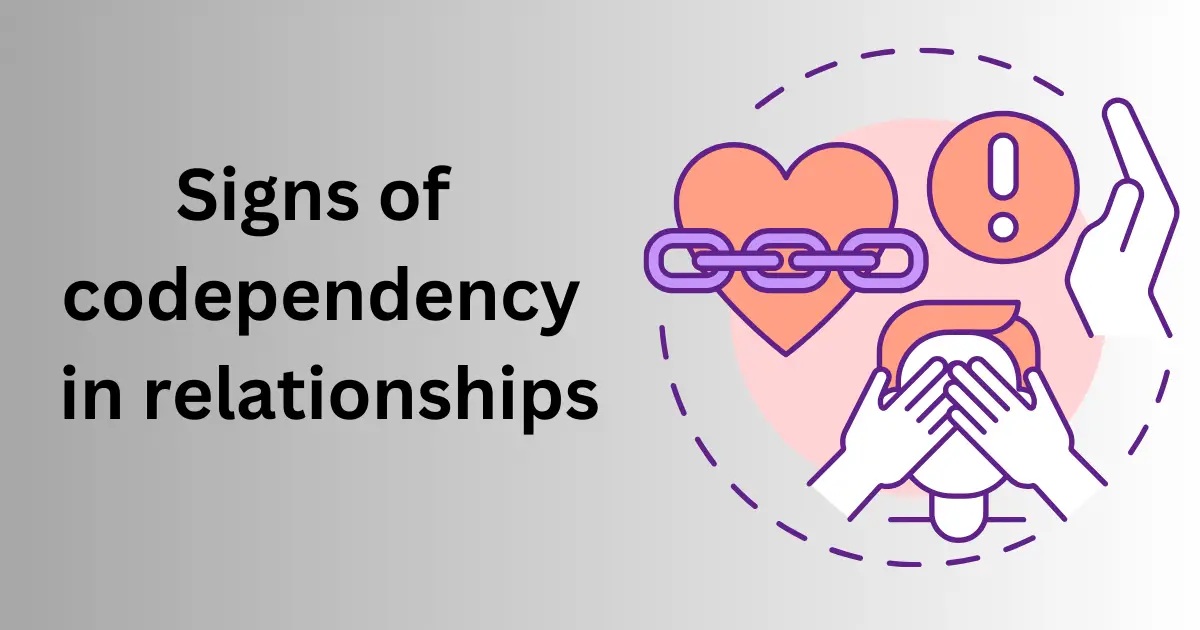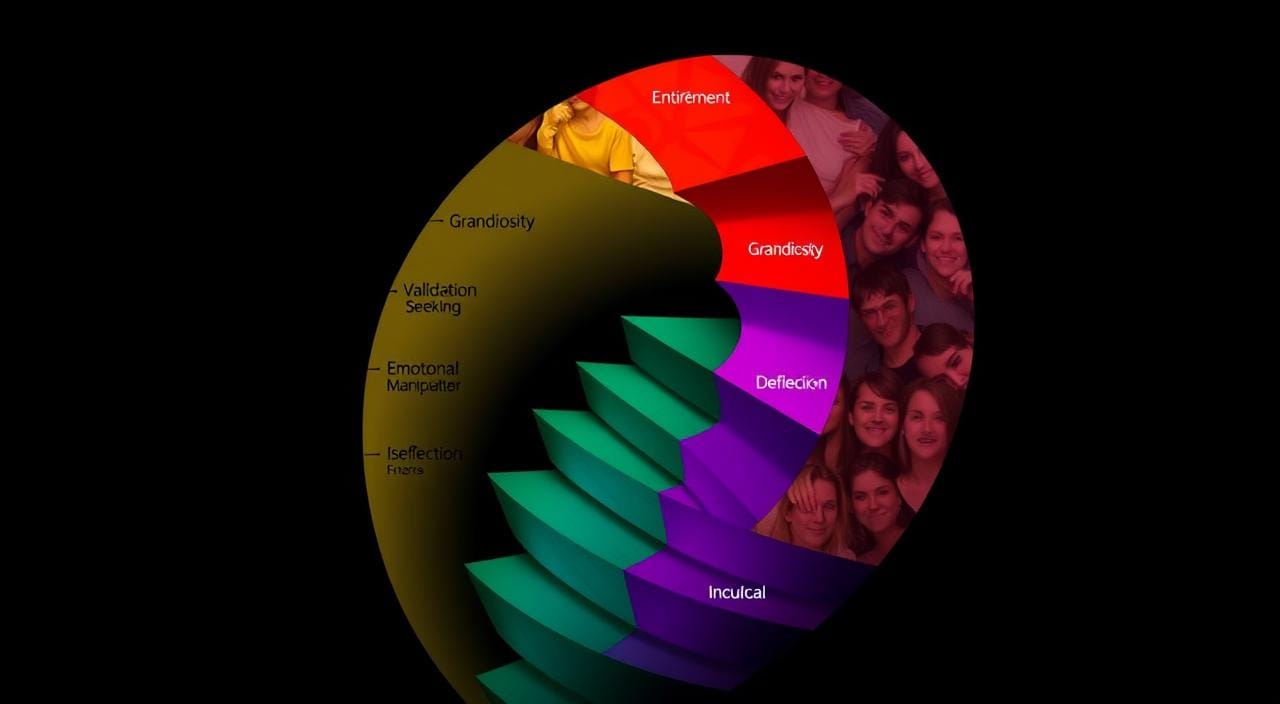Have you ever found yourself constantly putting your partner’s needs before your own, to the point where you’ve lost a sense of your own identity? This could be a sign of a codependent relationship – a dynamic where one person becomes overly reliant on the other, often resulting in a toxic cycle of enabling and resentment. But what exactly are the telltale signs of codependency, and how can we break free from these unhealthy patterns? Let’s discuss signs of codependency in a relationship.
Codependent relationships are characterized by an imbalance of power, where one person takes on the role of the “caretaker” while the other becomes the “taker.” According to experts, patterns of codependent behavior generally involve four main themes: self-sacrifice, focusing on others, a need for control, and difficulty recognizing and expressing1. This can manifest in a deep-seated need for approval from others, self-worth that is entirely dependent on external validation, and a habit of taking on more responsibilities than can realistically be handled. Codependents often avoid conflict and become excessively concerned about their partner’s habits and behaviors1.
Key Takeaways
- Codependency involves an imbalance of power, with one person taking the role of the “caretaker” and the other becoming the “taker”
- Common signs of codependency include a deep need for approval, self-worth based on external validation, and taking on excessive responsibilities
- Codependents often avoid conflict and become overly concerned about their partner’s actions
- Codependency can stem from childhood experiences, such as abuse, neglect, or having a caregiver with mental health issues
- Untreated codependency can lead to a disconnect from one’s own needs and desires, as well as emotional distress in relationships
What is Codependency?
Codependency is a dysfunctional relationship pattern where one person’s identity and self-worth become deeply intertwined with their partner’s needs and emotions2. This goes beyond everyday clinginess or dependence, as the codependent person’s entire sense of self becomes centered around pleasing and sacrificing for their significant other2. Now i will discuss signs of codependecy in a relationship.
Defining Codependent Behavior
Codependent behavior involves a strong desire for approval from others, difficulty setting healthy boundaries, and a tendency to ignore one’s own needs in favor of caretaking for a loved one2. Individuals with codependent tendencies often struggle to maintain a distinct identity within the relationship, finding it challenging to express their own emotions and desires2.
Codependency vs. Healthy Interdependence
In contrast to codependency, healthy interdependence in a relationship is characterized by both partners maintaining their own identities, expressing their needs openly, and finding joy in outside interests and social connections3. Interdependent individuals can rely on each other emotionally while still nurturing their individual growth and autonomy3.
| Codependent Relationship | Healthy Interdependent Relationship |
|---|---|
| Lack of personal identity, inability to function without partner | Both partners maintain separate identities and autonomy |
| Excessive caretaking, difficulty setting boundaries | Mutual support and respect for each other’s needs |
| Circular “giver-taker” dynamic | Balanced, reciprocal exchange of emotional support |
Codependency involves an unhealthy imbalance in a relationship, whereas healthy interdependence allows both partners to thrive as individuals while sharing a meaningful, mutually supportive bond.
Common Signs of Codependency in a Relationship
Codependent relationships can be intricate, with both partners often struggling to maintain a sense of individuality.
Setting Limits Challenge
Your life is a garden, but no one ever showed you how to put a fence up. You can’t say no to your partner or others even when their demands offend or bother you. It’s like the whole world over your flowers, and you have no idea how to protect personal space.
Low Self-Esteem
Imagine looking into the mirror and only seeing a blurry outline where you expect to see a face of clarity. You cannot attribute to your value and consider yourself often not good enough. This makes you largely dependent on your partner’s approval in order to be all right with who you are.
Obsession over Your Partner’s Problems
Then, it’s like watching a soap opera on TV, one whose episodes you cannot help but binge watch. You discuss their problems more than your own life. At times, you forgo your sleep to find ways to fix things for them even when they didn’t ask. End
Simply, envision yourself on a road trip. You so intensely care that your partner is comfortable that you forget to eat, rest, or even go to the bathroom. You place those basic needs and necessities of life on the backburner sometimes to a point where your health and wellbeing suffer .
Fear of Abandonment
It’s like you are always standing on the cliff, dreading to be pushed. This can make you cling to your partner, always trying to please them so they do not leave. You may tolerate harmful behavior or stay in a not-so-great relationship because, to you, the scenario of being alone seems unbearable.
Inability to Express Emotions
Imagine having a box of feelings inside you, but the key to unlock it is nowhere to be found. You don’t know how you feel and how to express those emotions, so you try to feel what you think your partner would want you to feel. You end up being cut off from others and even from yourself.
Trying to Control Through Caretaking
Now, imagine being a puppet master trying to control everything about your partner’s life by going under the guise of “helping”. You take over tasks for them, make decisions for them, and try to change them. This often usually comes from anxiety and a need to feel useful and needed.
Intimacy Problem
Consider it like a dance, only you can’t ever get in rhythm and keep tripping over your own feet. Maybe you are desperate for connection and then, when you get it, feel uncomfortable or anxious-again. So you do the sorts of things that attract emotionally unavailable partners or sabotage relationships that become too intimate.
Causes of Codependent Behavior
Childhood Experiences and Codependency
Codependent behavior often has its roots in childhood experiences. Trauma, adverse life experiences, and attachment are factors that can influence the development of codependent behaviors7. Individuals with low self-esteem may exhibit codependent behaviors, seeking validation and self-worth through relationships7.
Dysfunctional family dynamics, such as emotional or physical neglect, overprotective parenting, abuse, and substance abuse, can contribute to the formation of codependent tendencies in adulthood8. Children who grow up in unstable or unsupportive environments may develop a belief that their own needs are unimportant, leading them to prioritize the needs of others and seek approval through self-sacrifice8.
Childhood trauma, including trust issues, guilt, and shame, can significantly impact an individual’s ability to form healthy boundaries and communication in relationships, further perpetuating codependent patterns8. The link between childhood experiences and codependent behaviors is well-documented, with various studies highlighting the role of overparenting, emotional abuse, and substance abuse in the development of codependency8.
“Codependency is learned behavior, often developed in childhood in dysfunctional families. Dysfunctional families, where codependency often arises, experience issues like pain, anger, fear, or shame that are ignored or denied.”9
Understanding the root causes of codependency, particularly the link between childhood experiences and codependent behaviors, is essential for individuals seeking to break the cycle and develop healthier relationship dynamics78.
Impact of Codependency
Codependency can have far-reaching consequences on an individual’s self-worth and overall wellness. By constantly prioritizing their partner’s needs over their own, the codependent person may experience a profound loss of personal identity and self-esteem10. They may feel guilty or anxious about pursuing their own interests and dreams, becoming overly focused on controlling or “fixing” their partner’s problems10. This can lead to burnout, resentment, and a general sense of dissatisfaction with life10.
Codependent relationships often involve substance abuse, where the codependent partner may enable the addictive behaviors of their significant other10. This dynamic can hinder treatment outcomes and increase the risk of relapse, as the reinforcing nature of the codependent relationship can make it challenging for the addicted partner to break free10. Addressing codependency within the family unit during addiction treatment can have long-term benefits, even after the addiction treatment has concluded10.
Codependency can also strain other important relationships and hinder the codependent person’s ability to achieve their full potential10. Individuals in codependent relationships may neglect their own responsibilities, career, and everyday obligations to please their partner, potentially causing damage to their other relationships and overall well-being11.
Behavioral and personal therapy provided by psychiatric professionals can be effective in treating severe cases of codependency, assisting the individual in setting boundaries, defining their needs, and improving their self-worth for healthier relationships10. Learning to establish boundaries is crucial in addressing codependency, particularly in relationships involving substance abuse, allowing both partners to cultivate a healthier dynamic and potentially improve treatment outcomes10.
| Consequences of Codependency | Impact on Self-Esteem and Overall Wellness |
|---|---|
|
|
“Codependent relationships can occur between friends, romantic partners, or family members, and often encompass emotional or physical abuse11. Individuals in a codependent relationship may exhibit signs of finding no satisfaction or happiness outside of doing things for the other person11.”
Codependent Relationship Dynamics
In a codependent relationship, the dynamics are often characterized by an imbalance of power and control12. The codependent person may feel a constant need to please their partner and meet their every demand, while the “enabler” often takes advantage of this self-sacrificing behavior12. This can manifest in the codependent person making excuses for their partner’s harmful behaviors, neglecting their own needs, and becoming anxious or defensive when the relationship is challenged12.
At the heart of this dynamic is the enabler’s reliance on the codependent person’s caretaking, creating a cycle where both individuals struggle to maintain healthy boundaries and autonomy12. Low self-worth is a core component of codependency, leading individuals to constantly seek validation and fear rejection12. The codependent person may spend more time taking care of others than themselves, feeling guilty or selfish when doing something for their own wellbeing12.
Detaching, a concept central to codependency recovery, involves putting emotional or physical space between oneself and others to focus on self-care12. Emotional support, such as therapy, can help individuals in codependent relationships reduce feelings of loneliness and shame and increase motivation and accountability12.
Codependent relationships can occur between friends, romantic partners, or family members, not just intimate partners13. Research suggests that individuals susceptible to codependency may have grown up with childhood trauma, parents with mental health issues, or in environments where they witnessed similar experiences and behaviors13. If you have a parent or caregiver who was very unwell, needy, or demanding, you might have learned to be in service of others from an early age, suppressing your own needs along the way13.
Understanding the dynamics of codependent relationships is the first step towards breaking the cycle and reclaiming one’s own sense of self and autonomy. By recognizing the imbalance of power and control, and seeking support to develop healthy boundaries, individuals can work towards building more fulfilling and reciprocal relationships.
Breaking the Cycle of Codependency
Overcoming codependency requires a concerted effort and the support of mental health professionals. By seeking individual or group therapy, individuals can address the root causes of their codependent behavior, develop a stronger sense of self, and learn to set healthy boundaries14. This is particularly important as setting and reinforcing boundaries can be challenging, as they may potentially hurt the feelings of the other person involved in the relationship14.
Seeking Professional Help
Therapy, whether individual or in a group setting, can be instrumental in the recovery process. Codependent behavior often stems from low self-worth and a lack of self-trust, which can be addressed through professional guidance14. Practicing Loving Kindness meditations can also be beneficial in showing compassion to oneself and others during the codependency recovery journey14.
Building a Healthy Support System
Developing a supportive network of friends, family members, or support groups who encourage independence and self-care can be crucial in breaking the cycle of codependency14. This may involve pursuing new hobbies, reconnecting with neglected social connections, and learning to prioritize one’s own needs without feeling guilt or shame14. Free support groups like Al-Anon or professional therapists can also aid in the process of breaking the cycle of codependency14.
By seeking professional help and building a healthy support system, individuals can take the necessary steps to overcome codependency and develop more balanced and fulfilling relationships141516.
| Therapeutic Interventions for Codependency | Effectiveness |
|---|---|
| Group Therapy | Proven Effective |
| Family Therapy | Proven Effective |
| Cognitive-Behavioral Therapy | Proven Effective |
“Codependency recovery involves learning to tolerate and welcome your own emotions while respecting the emotions of the other person.”
Codependent Relationship Patterns
Codependent relationships often follow a predictable pattern, where the codependent person struggles to communicate their own needs and desires, fearing that expressing them will lead to abandonment or conflict17. They may become hyper-vigilant about their partner’s moods and behaviors, constantly trying to anticipate and meet their needs in the hope of maintaining the relationship17. This can create a dynamic where the codependent person feels a constant sense of anxiety and the need to “prove” their worth, while the enabler may become increasingly controlling or manipulative.
The inability to express their needs is a common issue for individuals in codependent relationships17. They may perceive themselves as completely unselfish and dedicated to the well-being of others, while lacking empathy for the feelings and needs of their partner17. This can lead to a constant fear of abandonment, as they believe their partner is incapable of taking care of themselves17.
Breaking this cycle requires both individuals to develop greater self-awareness, assertiveness, and the ability to engage in open, honest communication11. Seeking professional help, building a healthy support system, and addressing the root causes of the codependent behavior, such as past experiences or learned behaviors, can be crucial steps in the process11.
“The hallmark of codependency is an excessive reliance on others for approval and a sense of identity.”18
Codependent relationships can have a significant impact on the mental and physical well-being of those involved, often leading to higher stress levels, increased likelihood of addiction, and a diminished quality of life18. Recognizing the signs of codependency and taking proactive steps to address the underlying issues can be instrumental in breaking the cycle and fostering healthier, more fulfilling relationships.
Conclusion
Codependency is a complex and often deeply-rooted relationship pattern that can have devastating consequences on an individual’s mental, emotional, and physical well-being1920. By recognizing the signs of codependency, such as a lack of personal identity, excessive caretaking, and difficulty setting boundaries, individuals can take the first step towards breaking the cycle and building healthier, more balanced partnerships19.
This process often involves seeking professional help, developing a strong support system, and learning to prioritize one’s own needs and desires1920. With time, effort, and a commitment to personal growth, it is possible to overcome codependency and cultivate relationships that are mutually fulfilling and empowering1920.
While the path to healthier relationships may not be easy, addressing the importance of overcoming codependency is crucial for our overall well-being and the quality of our connections with others2120. By focusing on the summary of key points and taking proactive steps towards change, we can break free from the cycle of codependency and forge meaningful, sustainable relationships that enrich our lives2120.
Faqs on signs of codependency in a relationship
What is codependency?
Codependency is a type of dysfunctional relationship where one person is a caretaker, and the other person takes advantage. It is a circular relationship where the codependent person plans their entire life around pleasing the other person, or the “enabler”, to the point that their self-esteem and self-worth come only from sacrificing themselves for their partner.
What are the common signs of codependency in a relationship?
Common signs of codependency include a deep-seated need for approval from others, self-worth that depends on what others think, a habit of taking on more work than can be realistically handled, a tendency to avoid conflict, and a lack of personal identity outside the relationship.
How does codependency differ from healthy interdependence?
Codependency is a dysfunctional relationship pattern where one person’s entire identity and self-worth becomes centered around pleasing and sacrificing for their partner. This is in contrast to healthy interdependence, where both partners can express their emotions and needs, find joy in outside interests, and maintain their own identities within the relationship.
What are the common causes of codependent behavior?
Codependent behavior is often learned in childhood, stemming from dysfunctional family dynamics. Children who grow up with emotionally or physically absent parents, abusive or narcissistic caregivers, or family members with mental health or addiction issues may develop a belief that their own needs are unimportant.
What are the common patterns in codependent relationships?
Codependent relationships often follow a predictable pattern, where the codependent person struggles to communicate their own needs and desires, fearing that expressing them will lead to abandonment or conflict. They may become hyper-vigilant about their partner’s moods and behaviors, constantly trying to anticipate and meet their needs in the hope of maintaining the relationship.
Source Links
- Are You Codependent? Here Are the Key Signs of Codependency – https://psychcentral.com/lib/symptoms-signs-of-codependency
- What Is Codependency? – https://www.verywellmind.com/what-is-codependency-5072124
- Signs of Codependency – https://www.webmd.com/mental-health/signs-codependency
- How to Know Whether You’re in a Codependent Relationship and What to Do About It | All Points North – https://apn.com/resources/codependent-relationship/
- 20 Signs You’re In A Codependent Relationship & Why It’s Unhealthy – https://www.mindbodygreen.com/articles/signs-of-a-codependent-relationship
- 10 signs your partner is codependent – https://www.businessinsider.com/codependency-signs-partner-2018-12
- What Causes Codependency? – https://psychcentral.com/health/what-causes-codependency
- What Causes Codependency? — Talkspace – https://www.talkspace.com/blog/what-causes-codependency/
- Codependency: Causes, Symptoms & Treatment | Banner Health – https://www.bannerhealth.com/services/behavioral-health/conditions/codependency
- Signs of Codependency & Addiction (Impacts & Negative Effects) – https://americanaddictioncenters.org/rehab-guide/codependent-relationship
- Codependent relationships: Signs, examples, and more – https://www.medicalnewstoday.com/articles/319873
- 10 Signs You’re in a Codependent Relationship – https://www.psychologytoday.com/us/blog/conquering-codependency/202011/10-signs-youre-in-a-codependent-relationship
- What Is a Codependent Relationship and Are You in One? – https://www.relationshipsnsw.org.au/blog/signs-codependent-relationship/
- Breaking the Cycle of Codependency in Relationships – https://movetherapyandwellness.com/breaking-the-cycle-of-codependency-in-relationships/
- How to Fix an Addicted and Codependent Relationship – https://willingway.com/fix-addicted-codependent-marriage/
- How to Stop Being Codependent – https://www.verywellmind.com/what-s-the-best-codependency-treatment-5070487
- Patterns and Characteristics 2011 – CoDA.org – https://coda.org/meeting-materials/patterns-and-characteristics-2011/
- Are you in a codependent relationship? These are the signs – https://www.nbcnews.com/better/health/what-codependency-signs-codependent-relationship-ncna940666
- Codependency: What Are The Signs & How To Overcome It – https://positivepsychology.com/codependency-definition-signs-worksheets/
- Signs of Codependency in Relationships: Unmasking the Puzzle – https://lightworktr.com/signs-of-codependency/
- What Is A Codependent Relationship? – https://www.lifebulb.com/blogs/what-is-a-codependent-relationship







